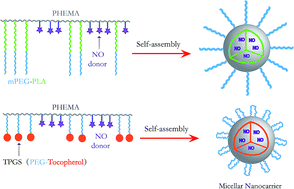Nitric oxide-releasing graft polymer micelles with distinct pendant amphiphiles
Abstract
A polymeric micelle is a versatile nanoscale platform for sustained release of short-lived nitric oxide (NO). The aim of this work was to better understand the correlation between polymer architecture and NO release kinetics. Stable nitrate was selected as the NO donor and co-conjugated to a multivalent polymer backbone together with amphiphilic methoxy poly(ethylene glycol) and poly(lactic acid) (mPEG–PLA), or D-α-tocopheryl polyethylene glycol 1000 succinate (TPGS). Both graft polymers could self-assemble into micellar nanocarriers with a size less than 100 nm. The weight-based NO loading was 4.92% (w/w) and 6.05% (w/w) for mPEG–PLA- and TPGS-modified micelles, respectively. The former is less stable than the latter with a corresponding critical micelle concentration of 23.9 ± 2.0 nM and 9.8 ± 0.5 nM. Using the standard Griess assay, it was shown that both micelles could achieve sustained NO release in vitro. However, the TPGS-modified nanocarrier exhibited a delayed onset, but faster steady-state release of NO in comparison to its counterpart. This was primarily due to folded PEG conformation and its high packing surface density. These results illustrate the potential utility of polymer architecture engineering to precisely tune the NO release behavior for ultimately optimum therapeutic outcome.


 Please wait while we load your content...
Please wait while we load your content...